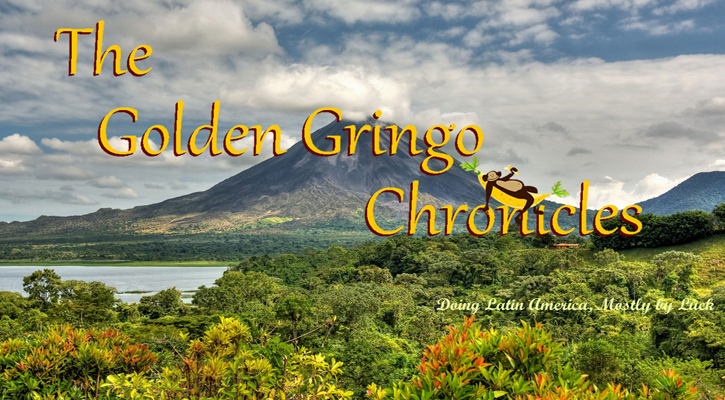

Edition 112 - December 2017
Published at Quepos, Province of Puntarenas, Costa Rica
Publisher: GGC Publications Group
Editor: Bob Normand, The Golden Gringo, aka "GG"
(©Copyright 2008-2017 All Rights Reserved)
"The mission and goal of the Golden Gringo Chronicles is to provide,
in an
informative and entertaining way, insight into
living
the
Costa Rican
experience as an expat."
1. Broken News: Teatro Nacionál - New-Old National Symbol; World Robotics Olympics; High Sticking; Gold Rush in San Carlos
2. Rumble and Weather Talk: Rains Diminish but Sudden Rumble Hits Jacó/Quepos Area
3. Feature: Small Town Stories - Episode 2 & 3 (Birthday Cards and Shashlyk)
4. Que Es Eso? Department: Dancing Reptile or Trick Photo?
5. Feature: How to Live To Be a Hundred (The Nicoya Secrets)
6. Health Stuff: Cashew Apples
7. What's-in-a-Word: Answer to ¿Que Es Eso?, The Extinguishing Machine
8. ROMEO Corner: Hotel Gaia, Manuel Antonio
Wisdom of the Ages
|
The Golden Gringo and the entire staff of GGC Publications (guess who that is) wish you and yours every blessing and good wish for the holidays.
 |
 |
¡Feliz Navidad y Feliz Hanukkah Amigos!
New-Old National Symbol
 |
| The Teatro Nacionál at Night |
If you ask most people how they know they are in the center of San José, they usually reference or point to the Teatro Nacionál. This turn of the last century building (1897) is one of the most important cultural centers in Costa Rica. Technically it's not at the very center of the capital, being located at Avenida 2 and Calle 3, 2-3 blocks from the actual center at Avenida Central and Calle Central.
But the Teatro and the adjoining Plaza de La Cultura dominate the central part of town. The Chronicles featured this beautiful landmark in an article in February of this year entitled: Teatro Nacionál, Culture at the Center of Things. There is almost always something going on at Teatro Nacionál from plays to opera and virtually every other type of performing art.
Movement is now afoot in the legislature to designate the Teatro a national symbol and provide new funds for update and renovation. I think many Ticos and expats would be surprised to think of the Teatro already as anything but a national symbol. Accordingly, one would expect there to be little dissension on that piece of legislation.
The Teatro celebrated its 120th anniversary on October 16.
World Robotics Olympics
 |
| Professor Sánchez at Work |
 The World Robotics Olympics was held on November 10-12 in San José.
The World Robotics Olympics was held on November 10-12 in San José.
The WRO was formed in 2004 to promote worldwide entrepreneurial creativity in the use of robots. This year was the 14th annual World Robotics Olympiad. It was also the first to be held in Costa Rica and the first ever to be run by a woman. She is Alejandra Sánchez, a 36 year old Costa Rican. When Sra. Sánchez is not teaching young people about robotics she is busy being a wife, mother and professor of mechanical and electronic engineering at the University of Costa Rica.
This year over 3,000 people attended the competition from some 60+ countries around the world. All competitors in the regular group are put on an equal footing by the rules that require the use and construction of their robots to be made only from a set of controllers, motors and sensors called LEGO® MINDSTORMS® (NXT or EV3). (My oh my, how Lego has grown up over the years). The competition in 2016 was won by a team from India.
 In addition to the general competition there also is 1) a last day speed rush to assemble a specified type of robot, 2) an Advanced Robotics Exhibition not limited to the Lego system, 3) an open competition based on a predesignated theme and 4) a world favorite, robot Football (or Futbol). The futbol competition is shown in the photo left. (Watch out Futbol Señores Navas, Messi and Rinaldo, the robots are coming!)
In addition to the general competition there also is 1) a last day speed rush to assemble a specified type of robot, 2) an Advanced Robotics Exhibition not limited to the Lego system, 3) an open competition based on a predesignated theme and 4) a world favorite, robot Football (or Futbol). The futbol competition is shown in the photo left. (Watch out Futbol Señores Navas, Messi and Rinaldo, the robots are coming!)
In this years open competition, teams from India and Asia dominated the winning ranks again, while Russian teams came in second or third in several categories. GG was disappointed to see no U.S. or Costa Rican team mentioned in the list of some 30 first, second and third place winners in ten categories. What's that all about my American amigos? But then, the competition's motto says it better:
"It is not whether you win or lose, but how much you learn that counts."
High Sticking
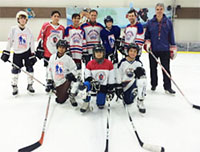 |
| The Castillo Knights |
 Tropical paradises aren't what they used to be.
Tropical paradises aren't what they used to be.
Jamaica has an Olympic bobsled team and Costa Rica has just finished its first International Ice Hockey Tournament.
The Chronicles has followed the development of hockey in Costa Rica, spurred on by Canadian and U.S. transplants of course, for some time now (see hockey). The first team in Costa Rica was formed last year and goes by the name Castillo Knights, largely because they play at the Castillo Country Club in Heredia Province (photo right).
 |
| Calgary Canadian Citizens Victorious |
In the current (invitational) tournament four teams participated: The Knights, a Canadian team called the Calgary Canadian Citizens (also described by one press report as the "Calgary beer league hockey team"), a team from the Falkland Islands and a U.S. team called the Los Angeles Ruination (love the name). The CCC's, ages from 30 to 50, have been described in press reports as "guys who played hockey all their lives but never really made it probably beyond high school hockey." Dude, give 'em a break, they put the skates on.
The games were played in a rink half the size of a professional league rink, with lower boards and no protective glass. Slap shots were verboten. (Does that make for a more gentile form of hockey with emphasis on skating and passing like in the good old days? - just a thought) The CCC's emerged champions and took home a nice trophy.
A modest beginning for international hockey in Costa Rica but it has to start somewhere. Keep this going amigos and some day we'll see the Bruins and Penguins here (they will come, if only to see Costa Rica).
Gold Rush in San Carlos
There must be gold in them, thar hills.
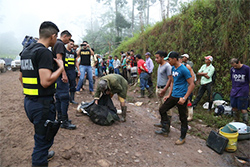 |
| "Amateur" Miners at Crucitas de Cutris |
A recent episode of the conflict between Costa Rican environmental advocates and a Canadian gold mining company took a different twist. Some 200 fuerza publica (national police) officers descended on the potential gold mining site and arrested over 80 amateur miners. Fifteen of them were charged with illegal mining and over sixty of them with "irregular immigration status".
This saga started almost twenty years ago when Infinito Gold Mining Ltd. proposed an open-pit mining operation for gold at Crucitas de Cutris, in San Carlos, a small town near the Nicaraguan border north of the central valley and San José.
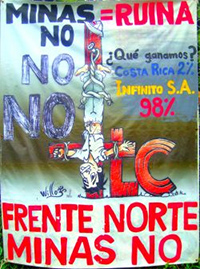 |
| Opposition Poster |
After several years of "discussion", environmental impact statements and haggling, the company was finally granted a "concession" or right to proceed in 2005. In the next five years a wide array of lawsuits were brought by environmentalists; the company's operations were alternatively red and green lighted so that the venture found itself unable to operate as planned. Finally in May 2010 the government issued a decree banning any operation that used cyanide or mercury, both used widely in gold extraction.
The company continued for some time to litigate the government's non-compliance with the concession but was stopped on every level. They initially sued the government for $1.1 billion in lost profit, then reduced their claim to $94 million and pursued it through the World Bank. The claims were vacated by the courts and the company's appeals dismissed.
 |
| The Infinito Gold Mining Project as it was Abandoned |
Despite a personal intervention by Canada's prime minister that tried to assure Costa Ricans that Canadian mining operations (extensive in the home country) are environmentally safe, the concession was withdrawn by the government and, in 2015 the company ceased operations in Costa Rica all together.
Evidently the rumor spread that there was some gold turned up in the early mining operations and an individual could find sufficient oro at the mining site to get rich quickly. So the Crusitas Gold Rush began. But gold mining just ain't gonna be allowed to happen amigos. So the government sent in police to stop the scavenging. It appears some of the amateur miners knew how to extract gold from ore as the police seized large quantities of shovels, picks, buckets and machetes as well as 3 kilos of mercury (6.6 lbs) plus other liquids and 136 kilos (300 lbs) of sediments, probably ore extracts.
Be gold diggers no more my amigos, with or without a concession.
¡Pura Vida!
 GGC Publications Group is the parent organization that publishes the Golden Gringo Chronicles as well as a number of books and paraphernalia related to the Chronicles and Costa Rica.
GGC Publications Group is the parent organization that publishes the Golden Gringo Chronicles as well as a number of books and paraphernalia related to the Chronicles and Costa Rica. The page is called GGC Publications Page - Products and has 3 sections:

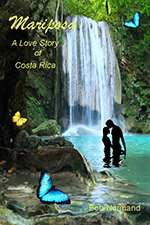 This section of the GGC Publications Page consists of descriptions of the following books published by GGC Publications:
This section of the GGC Publications Page consists of descriptions of the following books published by GGC Publications:Or go here for all of them: GGC Publications Page - Products Section I
Section II: Recommended Inspirational Books - Life Changing Stories

 S.O.B.E.R. - How the Acronyms of AA Got One Drunk Sober - by Ian Asotte (description and details HERE)
S.O.B.E.R. - How the Acronyms of AA Got One Drunk Sober - by Ian Asotte (description and details HERE)
◄To Eternal Happiness - by Abelardo Garcia, Jr. (see description and details HERE)
A Woman Awakens: Life, After-Life - by Jan Hart (see description HERE)►
Or go here to see all of them: GGC Publications Page - Products Section II
Section III: T-Shirts and Coffee Mugs All About Costa Rica and the Chronicles
In addition, GGC Publications Group now also offers t-shirts and coffee mugs that are related to the Golden Gringo Chronicles with Costa Rican themes, to wit:

 T-Shirts: a. Golden Gringo Chronicles with Logo, b. Official Golden Gringo with Monkey on Banana Hammock, c. ¡Quepo en Quepos! ("I Fit In Quepos!") with Photo of Quepos, d. Wanna Monkey Around - Come on Down! with Photo of White Face Monkey and e. It's OK to be Slothful with photo of Three-Toed Sloth.
T-Shirts: a. Golden Gringo Chronicles with Logo, b. Official Golden Gringo with Monkey on Banana Hammock, c. ¡Quepo en Quepos! ("I Fit In Quepos!") with Photo of Quepos, d. Wanna Monkey Around - Come on Down! with Photo of White Face Monkey and e. It's OK to be Slothful with photo of Three-Toed Sloth.
Coffee Mugs: a. Golden Gringo, b. Wanna Monkey Around?, c. OK to be Slothful
¡Solo Bueno!
Quepos, November 12, 2017 8:28 PM
On Sunday, November 12, 8:28 PM in Quepos, old GG was wondering what he could write about in this section since the rains had eased up and Nate or another tropical storm was not threatening the region. In addition, there had not been a tremor large enough to feel in months. All was quiet on the western front. But then, at precisely 8:28 PM my computer station and everything in my apartment began that too familiar dance that rudely announces an earthquake.
 The force of the shaking built in intensity over a five to ten second period. Half way through the experience GG began thinking of diving for his "safe space", a wedge between a built-in armoire and my bed about 10 feet from my computer station. The hope is that my "safe space" has a chance of creating a survivor "triangle", a technique I had read about and reported on back in 2011 (see that article here: Triangle).
The force of the shaking built in intensity over a five to ten second period. Half way through the experience GG began thinking of diving for his "safe space", a wedge between a built-in armoire and my bed about 10 feet from my computer station. The hope is that my "safe space" has a chance of creating a survivor "triangle", a technique I had read about and reported on back in 2011 (see that article here: Triangle).
In Quepos, the shaker only lasted about ten seconds but some reports said it lasted as much as 40-50 seconds to the north of us. After the ten seconds, the shaking dropped off precipitously. The post-shaker stats were impressive: a. epicenter 16 km (10 miles) southeast of Jacó which put it within about 40 km (25 miles) of Quepos, b. 6.5 on the Richter scale, exceeded only in GG's nine years here by the 7.6 monster in 2012 and c. 19.8 km in depth (12 miles); relatively shallow compared to the 41 km (25 miles) depth of the 2012 hospital destroyer.
 |
| Maxi-Pali in Esparza |
In our area, the power flickered several times and then went out, but the outage, which completely blacked out all of Quepos and Manuel Antonio, only lasted about twenty minutes and then the electric returned. About 25 miles to the north of Jacó, in the small town of Esparza, the shake, rattle and roll emptied a lot of shelves at a local supermarket (see photo right).
Later, the government reported three indirect fatalities due to the tremor, two people in their mid-fifties plus one who was only 25, all of whom suffered heart attacks and were pronounced dead on arrival at the hospital. Meanwhile, at the same time, the news stream was diverted to a much more serious earthquake (+400 fatalities) on the Iran/Iraq border that occurred about eight hours before the Costa Rica shaker.
I can now see why people say they never really get used to these things.
Check Out Recent Earthquakes Around the World Posted by the U.S. Geodetic Survey: Recent Quakes |
Search the Golden Gringo Chronicles Archives for Topics That Interest You
You can use our Archives to search for anything that has been written in more than 220 feature articles of the Golden Gringo Chronicles plus find Broken News items and ROMEO restaurant reviews. Enter your topic or item to search in the Google Search Routine below and follow the links offered from the search results. Suggestion: Enter only a simple, precise and unique as possible keyword or two in order to narrow the number of references retrieved:
Readers: Our publication is open to suggestions regarding future articles and will accept pieces written by others but we reserve the right to decline anything that the editorial staff (that's GG) thinks is inappropriate for this format. Send proposals, comments, suggestions, ideas, meaningless statements and jocular observations concerning the Chronicles to GG here: gg@goldengringo.com.
Small Town Stories - Episode 1 was an article in the September 2017, Edition 109 labeled "Quepos Qonvenience", which reported on getting things done in a typical day in Quepos. Recently GG had another interesting experience that compelled me to consider occasionally writing such stories and, et voila, here's #2. This story combines two distinct experiences in Quepos happening within an hour of each other.
It was nearing the dinner hour one day and GG was wandering around the mercado (market) area next to the Quepos bus station. I was trying to kill time, being about 45 minutes early for a dinner date. Then I remembered I needed to get a birthday card for a Tico friend and thought of a corner shop in the mercado called Wilber's. I knew Wilber would have some good cards, in Spanish, because I'd bought them there before. Wilber's is, not surprisingly, owned and operated by the famous Wilber whose been an icon at this mercado for a couple of dozen years (photo below).
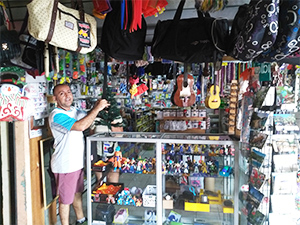 |
| Wilber Working His Shop |
Wilber's is the kind of place where you go to get the "odd thing" that is difficult to find and for which everybody seems to have a frequent need. In addition to birthday cards I've bought several pairs of reading glasses at Wilber's over the last few years, the simple magnifier type with lenses in wire or plastic trim. Wilber's has a good selection of reading glasses with magnifying powers from 1.25 up to 3.50 (I usually get along with 2.0). And they cost only about 2,500 colones or about $4.50.
A few months ago the Panasonic control for my TV went on the fritz and I remembered seeing similar controls on the wall at Wilber's. Sure enough, he had the exact replacement except that, unlike the one at home, the one he gave me worked. I had little doubt about that point because he powered up the unit at the shop and tested every button himself.
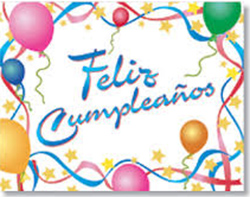 This evening and not at all out of the ordinary, Wilber was still working the store all by himself twenty minutes before the official closing time of 6 PM. I asked him, in my best Spanish ("Neccesito una tarjeta de cumpleanos para un buen amigo"), for his advice on selecting a card for a good friend. He responded in English, "Come with me" and we went across the aisle to the greeting card rack (his store is actually in two parts located across a public walkway inside a mall).
This evening and not at all out of the ordinary, Wilber was still working the store all by himself twenty minutes before the official closing time of 6 PM. I asked him, in my best Spanish ("Neccesito una tarjeta de cumpleanos para un buen amigo"), for his advice on selecting a card for a good friend. He responded in English, "Come with me" and we went across the aisle to the greeting card rack (his store is actually in two parts located across a public walkway inside a mall).
Wilber fingered several cards on the rack, reading the message on them and then presented me with a very attractive one with a picture of a fiesta and a wine bottle on the front. I remarked that it was indeed a pretty card but my friend doesn't drink anymore. The cover would be inappropriate. After that, something made me say: "I don't drink anymore either." to which Wilber responded, "Yo tampoco" (me, neither).
Wilber then told me the story of his father who had passed away some four years ago. Up until the last ten years of his life his dad had been a heavy drinker and often ended up passing out at home at night. Then one day the old man said to him: "No más, se acabó" (No more, it's over) and he never drank again and neither did Wilber, emulating his dad. At this I blurted out: "Es un milagro, amigo" (It's a miracle), to which he simply smiled.
I left Wilber at closing time, GG having developed an even stronger bond with a Costa Rican friend and fellow life traveler.
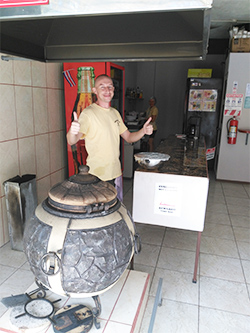 |
| Vlad Behind His Clay Oven with Milla in the Background |
I then met my Tico friend and suggested a new and strange place for dinner, the Shashlyk place. Being Tico, my friend at first had difficulty pronouncing shashlyk (sha-sh-leek) but then so did I. I had seen placards posted around town as well as in the local buses proclaiming genuine Ukrainian shashlyk was now available in Quepos. So I thought: now that's something different to try.
Shashlyk, of course, is simply a dish of skewered and grilled cubes of meat, a food popular in: Ukraine, Iran, Russia, Belarus, Romania, Bulgaria, Croatia, Poland, Hungary, Latvia, Lithuania, Estonia, Armenia, Azerbaijan, Georgia, Afghanistan, Israel, Iraq, Mongolia, Morocco, Pakistan, Turkey and now, of course, Quepos. Some people call it shishkabob but I found shashlyk to be much more than just shishkabob.
So we located the restaurant in a small cubicle near the bus station, across the street from the Quepos carniceria (meat store), and only about a half block from Wilber's emporium. We were greeted by a gent who I had seen about Quepos several times but had not yet had the pleasure of meeting. His name is Vladimir ("Vlad" - and he was quick to say "not Vladimir Putin") and he introduced us to his wife Ludmilla ("Milla") who was very busy in the kitchen preparing meals and organizing things.
The first thing I noticed was something odd just inside the entrance to Shashlyk, S. A. (that's also the official name of the business and restaurant). The odd item was a strange looking round thing with an elaborate design on its surface (see photo). I suspected its use as an oven because it was throwing off heat. It looked to me to be either a cooker or a left-over native-American burial jar from the first millennium. Thinking about it further I came to the conclusion it's also something that could double as a heater on those cold Ukrainian winter nights.
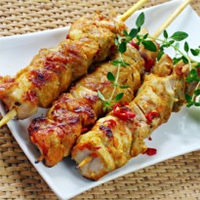 |
| Shashlyk Anyone? |
Vlad explained that this device is where the Shashlyk is cooked to perfection. The skewers containing meat and vegetables are hung vertically in the center of the oven. The heat, both radiant and convection, is provided by slowly burning wood inside and around the center in compartments near the outer wall. That particular method also adds a bit of delicious smoky flavor to the meat and vegetables.
I returned a few days later to ask if there was a special name for the oven. "Clay Oven" says Vlad. That works for me amigo. The clay construction allows for the elaborate external design to be permanently glazed onto the outer surface.
I was curious about one other thing. Vlad talked about something called "night meat". "Wazzat, amigo", says GG? He explained: in this process, the meat is literally massaged (yeah, that's right, massaged),several times during the day with 17 spices, including six different kinds of pepper. That night, the meat is put into the cooker and slowly roasted overnight by a dying fire. The net result is an extremely tender, slow cooked shashlyk that, according to Vlad, is best served cold with a good wine. So I tried night meat cold with some Ukrainian spiced potatoes - outstanding, rico amigos, cмачна (Ukranian for yummy)..
The Shashlyk place is too small for tables and chairs so take out is a good option, but it does have a counter where my friend and I ate while standing. Vlad said they are still waiting on stools they ordered, built to service the counter. He believed the stools will be built and delivered soon (in good Tico time, of course). Stools or no stools, in GG's opinion, the food is worth standing for. At this time, Shashlyk is being offered by Vlad and Milla only in pork based products but I've already begun lobbying for some good lamb. With those Ukrainian spices lamb cooked that way would be truly awesome.
But one of these days GG wants to talk to Vlad about the name for the place (sorry Vlad, once a business consultant, always a business consultant). Calling it the Shashlyk place gets old quickly. How about "Carne de la Noche" (Night Meat); that will cause curiosity among the natives and expats alike? Or maybe one of our readers can come up with a twist on the Ukrainian translation of "night meat" which is Ніч м'яса.
OK, I know Vlad, you have six licenses on the wall made out to the business name Shashlyk, so back off Bob. But maybe we can talk more a little later amigo. Until then...
¡Pura Vida! or Великий життя! (Ukrainian for Great Life!)

What is this little guy up to?
Is it a gecko?
Is it a lizard?
Is it a trick photo?
Answer in What's-in-a-Word section below.
¡Solo Bueno!
Shortly after the World Robotics Olympics concluded in San José (report above), another world meeting began in the Nicoya peninsula. This one was called the World Meeting of Blue Zones.
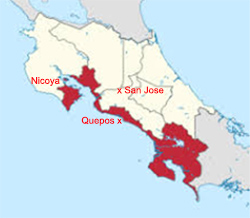 The map to the right shows the Nicoya's physical relationship within Costa Rica. The peninsula is partly in Guanacaste province and partly in Puntarenas province (burgundy color). Puntarenas province is also the home of a number of well-known cities and towns including, going from north to south, Puntarenas, Jacó, Parrita, Quepos, Dominical and Golfito.
The map to the right shows the Nicoya's physical relationship within Costa Rica. The peninsula is partly in Guanacaste province and partly in Puntarenas province (burgundy color). Puntarenas province is also the home of a number of well-known cities and towns including, going from north to south, Puntarenas, Jacó, Parrita, Quepos, Dominical and Golfito.
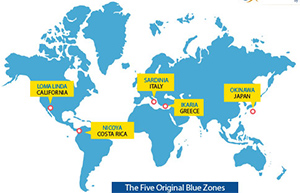 The Chronicles has been following the Blue Zone story for some time as it includes the incredible designation of the Nicoya peninsula as the largest of five "Blue Zones" in the world.
The Chronicles has been following the Blue Zone story for some time as it includes the incredible designation of the Nicoya peninsula as the largest of five "Blue Zones" in the world.
A Blue Zone, as designated by the United Nations, is an area that contains an above average percentage of centenarians, i.e., people over 100 years old. The other four Blue Zones are Icaria in Greece, Sardinia in Italy, Okinawa in Japan and Loma Linda in the United States (yeah, that's right, Loma Linda in San Bernadino County, California). One thing seems obvious from the map at left: none of the Blue Zones is terribly far from the equator, none either strongly north nor strongly south.
The Nicoya is not just rich in centenarians, approximately 50 at this writing, but in other advanced age groups as well. Nonagenarians for example are much more prevalent here, there being almost 900 people over 90 years of age. The average life span currently in Costa Rica is 80 (77 for men, 82 for women), about the same as the United States, but in the Nicoya the life expectancy for men exceeds the national average by 15 years, i.e., the average is 92. For Nicoya women, their average lifespan beat the national average by 9 years at 91. A man who turns 90 in the Nicoya can be expected to live another 4.4 years, say the experts.
Studies of the centenarians in the Costa Rican Blue Zone have been going on for quite a while now and the World Meeting of Blue Zones was held to discuss the findings so far. Certain factors, not all of which will seem strange or new to the reader, have been recorded, analyzed, and reported, to wit:
Low Stress
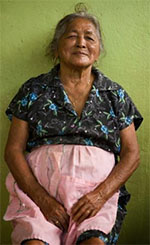 |
| Maria Says: "What Me Worry, With My Telomeres?" |
As we age from a child to an older person our chromosomes shorten due to inadequate replication of their tail endings which are called "telomeres" (OK, whatever; this talk gets a little too biological for GG). Many scientists equate the rate of shrinkage of telomeres to stress; the more stress, the faster the decline. Lack of stress slows the decline of the loss of telomeres in the average person and thereby slows the aging process.
Life in the Nicoya is considered low stress and people who have lived their entire life there have experienced a long period of low stress.
Hard Drinking Water
The water in the Nicoya is filtered through limestone resulting in drinking water that is higher in calcium and magnesium. Scientists believe the low rate of heart disease and the presence of stronger bones is directly related to the high content of these minerals, particularly calcium.
Basic Food and Light Meals
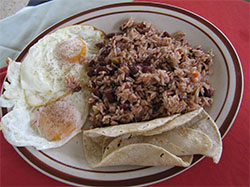 |
| A Nicoyan Breakfast is Ready |
Nicoyans tend to eat lighter meals, particularly at dinner. They are known to eat a large breakfast, a moderate lunch and a small dinner. They also prefer simplicity in their food and thrive on fortified maize (corn) products such as tortillas, present at almost all meals, rice and beans (red or black), white rice, eggs, several kinds of squash and fresh fruit. Gallo Pinto (black beans with white rice and a smattering of chopped vegetables like sweet pepper) for breakfast is very common. One of GG's variations to the photo at the left is to replace the eggs with fried cheese and maduros (ripe, sweet plantains fried in butter). Hmmmm, I wonder what the American Heart Association thinks of this? Buck it up docs.
The Nicoyans eat more chicken, pork and fried eggs than other Blue Zoners. They also consume large quantities of fruit including mango, papaya, passion fruit, plantains (generally fried), mamones (lichee nuts), guava, marañón (the seed is a cashew), pejibaye, star fruit, zapote, coconut, pineapple, cantaloupe, blackberries, lemons and limes.
Sunshine
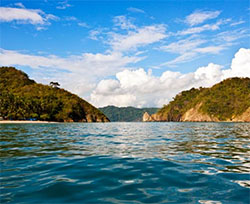 |
| Some Sunny Islands Just Off the Southern Tip of the Nicoya |
And then there's the sun. The Nicoyan peninsula enjoys long sunny, rain-free periods from November to April and only partially rainy months during the rest of the year. The heavy rain months are August thru November. The Nicoya Peninsula is a transition from the jungle like rainforest in the south to dry conditions going north where the summers are hot and arid like in Guanacaste. During the summer season the average daily high temperature, moderated by sea breezes on three sides, runs from a high of 88F +/- 4 degrees to a low of 73F +/- 2 degrees (hardly life threatening). Rainy season temperatures are, of course, a few degrees lower in both categories but very few days do not have some hours of sun.
It's well known that sun promotes the development of vitamins, particularly D and there is no shortage of good rays on the Nicoya peninsula. In addition to enhancing "D" production, scientists note that: "sunshine has a number of other health effects unrelated to vitamin D production, including enhancement of mood and energy, melatonin regulation, suppression of MS symptoms, and the treatment of skin diseases".
So this is thought to be another factor in favor of the Blue Zone aging experience.
Physical Work
 The great majority of older Nicoyas including the centenarians report that they "...have enjoyed physical work of all their lives and that they find joy in everyday physical chores". These are basically farming communities.
The great majority of older Nicoyas including the centenarians report that they "...have enjoyed physical work of all their lives and that they find joy in everyday physical chores". These are basically farming communities.
And it's not hard to find physical effort and exercise in a society that is simple and agrarian. Much of the crops they consume and that were mentioned above are grown in local farms and private plots and harvested manually.
"Plan de Vida"
To a Nicoyan, or any Costa Rican for that matter, this term means they have a Life Plan or a good reason to live. This thinking motivates them to have a positive outlook, particularly among the elders where the attitude helps keep them active.
Family and Community
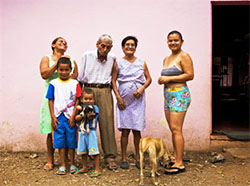 Also part of their positive attitude is an emphasis on family and community. These people don't discard their elders nor inventory them in old age homes. The elders are an integral part of their families and several generations often live together where the older folks are called upon to share their experiences. Take a look at the picture of a Nicoyan family to the right - I count four, maybe five generations in that photo (not counting the cat or dog). At least four of those generations are smiling.
Also part of their positive attitude is an emphasis on family and community. These people don't discard their elders nor inventory them in old age homes. The elders are an integral part of their families and several generations often live together where the older folks are called upon to share their experiences. Take a look at the picture of a Nicoyan family to the right - I count four, maybe five generations in that photo (not counting the cat or dog). At least four of those generations are smiling.
So there's the answer on how to grow old gracefully amigos and with a smile. There's nothing too clever, no magic pill, just a bit of common sense, easy living and working hard. It's about Low Stress, Hard Water, Basic and Light Food, Sunshine, Physical Work, a Plan de Vida and enjoying Family and Community.
Do these simple things, like the Nicoyans do, and first thing you know you might be a nonagenarian or even a centenarian.
Fancy that.
¡Solo Bueno!
| Note: The information given in this section is offered as news information only and does not indicate GGC confirmation or denial of the accuracy of the treatment or a recommendation to pursue it, nor can we or do we guarantee the efficacy of the results nor validity of the conclusions proffered.
(How's that for a disclaimer?) |
 |
| Cashew Fruit (Marañón) on the Tree |
It was pointed out in the article on the Nicoya Blue Zone that the consumption of large amounts of fruits is likely one of the contributors to a longer life span in that region. And one of the more interesting fruits of Costa Rica available there and in other parts of the country is the marañón (pronounced mah-rah-ne-yohn). Some people know it simply as the cashew apple.
This fruit grows on large trees, as much as thirty feet high or even more, and consists of two parts; a smallish apple and a shell growing out of the bottom of the apple in which you can find a cashew nut (actually it's a seed of the tree). The apple is sweet when ripe, contains generous amounts of proteins, vitamins, minerals and antioxidants. In can be eaten raw when ripe and it's often also made into a drink (so what fruit isn't in Costa Rica)? Cashew apples offer anti-bacterial properties and studies show that extracts of the apple juice have efficacy in treating stomach ulcers and gastritis.
 The cashew pod, that ugly gray, shrinkled thing hanging below the apple, as well as the enclosed nut need to be treated with care and caution. You do not just break open the pod and eat the nut. The cashew nut and its covering contain urushiol oil, the same oil that is credited (debited?) with causing poison ivy, poison oak, and poison sumac. The pods are processed by roasting them and then breaking open the pods to retrieve the processed nuts that are then edible.
The cashew pod, that ugly gray, shrinkled thing hanging below the apple, as well as the enclosed nut need to be treated with care and caution. You do not just break open the pod and eat the nut. The cashew nut and its covering contain urushiol oil, the same oil that is credited (debited?) with causing poison ivy, poison oak, and poison sumac. The pods are processed by roasting them and then breaking open the pods to retrieve the processed nuts that are then edible.
This is probably why many cashew apples you find in the ferias and markets already have the pod removed. The fact that cashews come only one to a fruit and in light of the processing that needs to go on, it now begins to make sense why cashews are so expensive.
There you go, another consumable wonder from Ticoland.
"Ladies and Gentlemen, as you exit the plane, please make sure to gather all of your belongings. Anything left behind will be distributed evenly among the flight attendants. Please do not leave children or spouses."
- Unidentified Airline (my bet is on Southwest) |
Answer to Que Es Eso?
The formal name for that reptile is a Basilisk Lizard but it is more commonly known as a Jesus Christ or Jesus lizard because of its ability to walk on water. Check out the video to the left. The Basilisk is a fairly common species native to Costa Rica.
The first time I saw one it walked across a swimming pool, reminding me of the Broadway play, "Jesus Christ Superstar" and one of its more interesting lyrics:
"♫Prove to me that you're no fool, walk across my swimming pool!♪").
The one in the video above is on the hunt and catches his lunch, a beautiful Morpho butterfly. (bad lizard, bad lizard)
(N.B. Don't forget to click on the screen expansion square to get a full screen view)
Extinguishing Machine
GG was reading a news report recently about a fire in a room at the Delrey Hotel in San Jose, a landmark hotel which is a couple or three blocks from the Teatro Nacionál. It is a well known as a place off ill repute (if you don't know what that means millennials, ask your grandpa). The report said 10 "extinguishing machines" were sent to quell the blaze. Maybe that's the new politically correct word for fire truck?
Hotel Gaia, Manuel Antonio
Location: Next bus stop after the Mono Azul heading to the beach.
Hours: Breakfast, Lunch, Dinner Sunday through Saturday (it's a hotel after all).
Parking: Some parking at the lower gate, more available across the main MA road from the gate.
Contact: Tel.: 2777-9797; Website: http://www.gaiahr.com/; Email: Contact through website.
Reviewing ROMEOS: Anita M., Bob N., Glenn N., Julia S.
To Review Our Rating System and Procedure, go here: R.O.M.E.O. Rating System
The Gaia is located at the peak of Manuel Antonio hill and offers one of the most spectacular views of the tops of the rainforest, of the Pacific and of the coast running north.
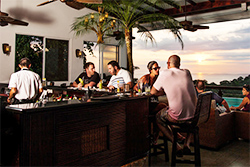 |
| Gaia Bar Area and View |
To get to the restaurant one leaves their car at the bottom of the hill, or exits a bus or taxi there, and is scooted up the hill in a covered golf cart that can accommodate about six people. At the top there is an elevator at the first floor spa level of a three story building where the restaurant occupies the second floor.
Tip: If you're arriving in the daylight, first take the elevator up to the third floor where you'll find an observation deck with a 360 degree panorama of the nature preserve surrounding the hotel with the central mountain range of Costa Rica (cordillera central) as a backdrop and the Pacific coast running up north to the horizon. Breathtaking. It's just one floor down by elevator or a quick flight of stairs to the restaurant from which you can get at least half the same view as the observation deck.
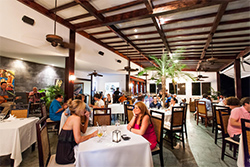 |
| Gaia Dining Room |
The restaurant and bar area are open to the atmosphere on the west side where the view and the sunset are truly incredible. The dining area is what might be described as sleek, modern elegance. The chairs are dark wood (padded - yes!) and the room is lighted with indirect lighting giving it a gentle ambiance. The table decorations are simple and functional. The ROMEO group was unanimous in giving Gaia a 5.0 out of 5.0 sloth rating for ambiance.
We started with tapas (hor d'oeuvres) in the bar area and moved over to the dining room later. GG started with some slightly seared and peppered fresh tuna slices with a mild wasabi sauce. Another ROMEO had the chicken sateh and reported it delicious (I've had that one there before and it is indeed good).
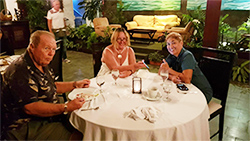 |
| The ROMEOs Hard at Work |
The menu is quite extensive and offers an array of seafood and meat selections in both traditional and some creative ways. GG had a seafood bisque accompanied by a side dish of fettuccine, both of which were fresh and cooked just right ("au point" the French would say). GG had one minor complaint: both the bisque and the fettuccine were spiced more than I like and I don't remember being warned of that on the menu.
Other ROMEOs had 1) baby ribs with a tamarind sauce accompanied by Gorgonzola croquettes, 2) mahi-mahi baked in a banana leaf, and 3) a mango, avocado and plantain vegetarian dish. GG knocked off a point or so for the unexpected spice but the other ROMEOs gave their food the top rating.
The desserts were irresistible to a couple of us.
GG had a piece of the Gaia Lime Pie (top photo left). A fluffy stuffing of lime flavored cream on chocolate crust with chocolate shavings. Yes.
Another ROMEO had a concoction consisting of very thinly sliced pineapple stuffed with a creamy cheese and enhanced with several accompanying fruits, hazelnuts and cream. Nuff said.
The composite ROMEO score for food overall for the evening came in at 4.63 sloths.
Service was provided by a young fellow named Aldo who was friendly, courteous and attentive. The kitchen seemed a bit slow at times but more creative meals take a little longer. Our composite score for service came in at 4.75. |
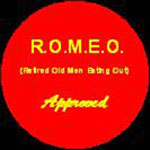 |
||||
|---|---|---|---|---|---|
| $$$$ | |||||
Value Index= 120 |
Adding the scores for ambiance, food quality and service yielded a composite score of 4.79.
For the tapas (tuna), bisque and lime pie, as well as two soft drinks, my bill came in a little over 17,000 colones (or just about $30). In my opinion that is quite reasonable for that quality of food and for Manuel Antonio. The composite score from the ROMEOs for cost was a unanimous 4.0 which yielded a Value Index of 4.79/4.0x100=120 which puts the Gaia in the top 10 list of restaurants we have reviewed in this area for value.
The ROMEO group can heartily recommend Hotel Gaia for an excellent meal at a reasonable price.
¡Pura Vida!
The Golden Gringo Chronicles is a free newsletter that is non-political, non-commercial and, hopefully, entertaining. By signing up you will receive an email each month around the first of the month giving you the links to the latest edition as well as to each individual feature and departmental section.
CLICK HERE TO SIGN-UP FOR THE
GOLDEN GRINGO CHRONICLES
or Email me at gg@goldengringo.com, and see our Website at: www.goldengringo.com

Bob Normand, Editor
& The Golden Gringo
Pura Vida!
To Contact GGC World Headquarters (yuk, yuk) to make comments, suggest topics or criticize my bad jokes, just send an email to: gg@goldengringo.com.
Be pithy but kind; I'm sensitive. (center)
Unsubscribe from Golden Gringo Chronicles